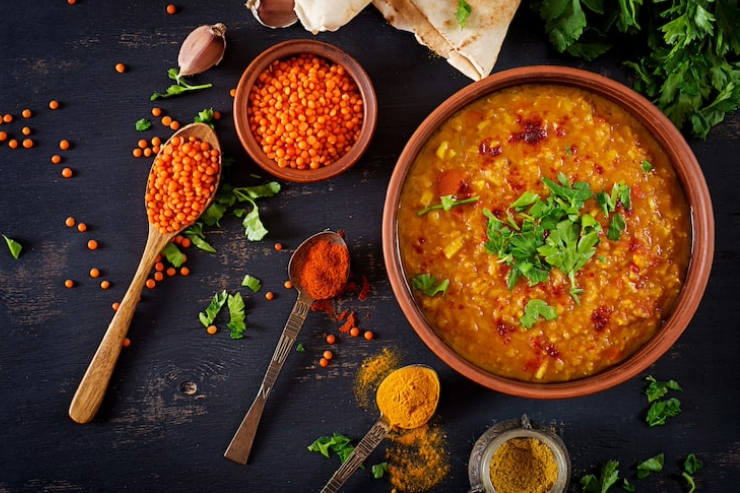Dal Tadka Gone Wrong? Common Mistakes and How to Correct Them
A steaming bowl of dal tadka with jeera rice is pure comfort food. But even this simple, classic dish can go wrong if you’re not careful. Too thick, too bland, too oily, or lacking that smoky aroma one misstep can ruin the experience. Don’t worry! Here’s how to fix the common mistakes that often spoil homemade dal tadka.
Skipping the Soak
Soaking your dal is essential for a creamy, evenly cooked texture. Even a short 30-minute soak in warm water helps lentils cook faster and absorb flavors better. For best results, soak for an hour before cooking. Without this, your dal may turn out grainy or unevenly cooked.
Using Only One Type of Dal
Mixing dals creates depth of flavor. Restaurants often blend toor, moong, and masoor dal for a balanced taste. Using only one type can result in flat, one-dimensional flavor. Try a mix 2 parts toor, 1 part moong, 1 part masoor to achieve that nutty, comforting taste.
Adding Tadka Too Early
The tadka (tempering) is the heart of dal tadka, but timing is crucial. Adding it too soon dulls the aroma and leaves ghee floating separately. Always pour the tadka just before serving, letting the sizzling ghee release its smoky, garlicky magic.
Overdoing Garlic and Chillies
Strong tadka is tempting, but too much garlic or chili can overpower the lentils’ earthy flavor. Stick to 4-5 garlic cloves and one slit green chili per batch. Let the ghee carry the aroma it’s more fragrant than extra spice.
Ignoring the Consistency
Dal should be creamy, not sticky or watery. Stir gently on low heat after adding water to achieve a smooth, pourable texture. If it thickens after resting, whisk in a little hot water before serving for that perfect restaurant-style consistency.
Using Old or Low-Quality Ghee
Ghee makes the tadka shine. Old or low-quality ghee can taste stale or burnt, ruining the dish. Always use fresh, pure ghee for nutty aroma and flavor. For a vegan option, mustard oil works just heat until the raw smell disappears.
Perfect dal tadka takes patience, practice, and attention to these simple details. Mastering them ensures every bowl is creamy, flavorful, and comforting the way it’s meant to be.

Skipping the Soak
Soaking your dal is essential for a creamy, evenly cooked texture. Even a short 30-minute soak in warm water helps lentils cook faster and absorb flavors better. For best results, soak for an hour before cooking. Without this, your dal may turn out grainy or unevenly cooked. Using Only One Type of Dal
Mixing dals creates depth of flavor. Restaurants often blend toor, moong, and masoor dal for a balanced taste. Using only one type can result in flat, one-dimensional flavor. Try a mix 2 parts toor, 1 part moong, 1 part masoor to achieve that nutty, comforting taste.You may also like
- 'Dialogue is always better than confrontation': Putin on cancelled Budapest meeting with Trump
- Investor Sells ArisInfra Shares Worth INR 7.4 Cr
- White House East Wing demolished as Trump moves forward with ballroom construction
- Democrats urge Donald Trump to stay home amid government shutdown as White House confirms meeting with China's Xi Jinping
- "BJP doesn't want Nitish Kumar to become Chief Minister", claims Tejashwi Yadav
Adding Tadka Too Early
The tadka (tempering) is the heart of dal tadka, but timing is crucial. Adding it too soon dulls the aroma and leaves ghee floating separately. Always pour the tadka just before serving, letting the sizzling ghee release its smoky, garlicky magic. Overdoing Garlic and Chillies
Strong tadka is tempting, but too much garlic or chili can overpower the lentils’ earthy flavor. Stick to 4-5 garlic cloves and one slit green chili per batch. Let the ghee carry the aroma it’s more fragrant than extra spice.Ignoring the Consistency
Dal should be creamy, not sticky or watery. Stir gently on low heat after adding water to achieve a smooth, pourable texture. If it thickens after resting, whisk in a little hot water before serving for that perfect restaurant-style consistency. Using Old or Low-Quality Ghee
Ghee makes the tadka shine. Old or low-quality ghee can taste stale or burnt, ruining the dish. Always use fresh, pure ghee for nutty aroma and flavor. For a vegan option, mustard oil works just heat until the raw smell disappears. Perfect dal tadka takes patience, practice, and attention to these simple details. Mastering them ensures every bowl is creamy, flavorful, and comforting the way it’s meant to be.









